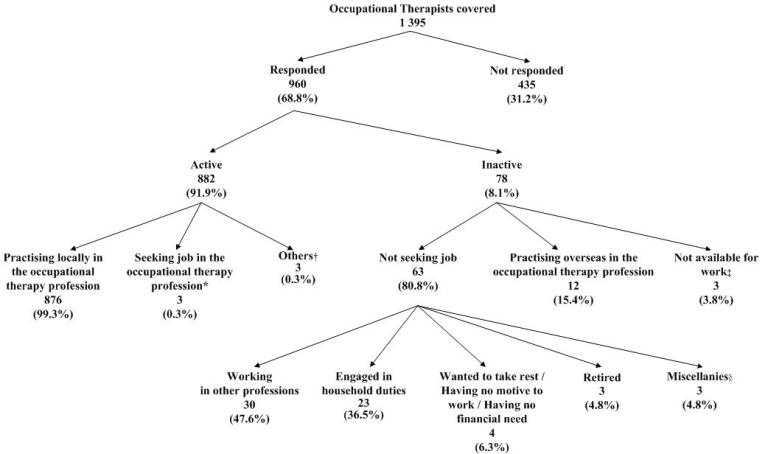Statistics
2011 Health Manpower Survey on Occupational Therapists
Key Findings
1. The occupational therapists covered in the 2011 HMS were occupational therapists registered with the Occupational Therapists Board of Hong Kong under the Supplementary Medical Professions Ordinance (Chapter 359) as at the survey reference date - 31.3.2011.
2. The number of occupational therapists covered was 1 395.
3. Of the 1 395 registered occupational therapists covered, 960 had responded to the survey, giving an overall response rate of 68.8%. Of the 960 responding occupational therapists, 882 (91.9%) were economically active *† (active) whereas 78 (8.1%) reported to be economically inactive *‡ (inactive) in the local occupational therapy profession (See Chart) .
4. Of the 882 active occupational therapists, 876 (99.3%) were practising in the local occupational therapy profession, three (0.3%) were seeking jobs and three (0.3%) were starting business in the local occupational therapy profession at subsequent date or having temporary sickness during the 30 days before the survey.
5. The survey findings presented below were based on the 876 responding occupational therapists practising in the local occupational therapy profession as at 31.3.2011. As some questionnaires contained missing information, percentages presented below may not add up to 100%.
|
(i) |
pSix occupational therapists did not indicate their sex. Of the remaining 870 active occupational therapists enumerated, 259 (29.8%) were male and 611 (70.2%) were female, giving an overall sex ratio (males per 100 females) of 42. 16 occupational therapists did not indicate the age and the median age of the remaining 860 active occupational therapists enumerated was 36.0 years.p |
|
(ii) |
Distribution by sector of the main job § showed that 422 (48.2%) were working in the Hospital Authority, followed by 294 (33.6%) in the subvented sector, 75 (8.6%) in the private sector, 50 (5.7%) in the academic sector and 33 (3.8%) in the Government. |
|
(iii) |
86.4% spent most of their working time on rehabilitation, followed by 8.8% on administration / management and 1.7% on primary health care ¶ , 1.6% on teaching and 1.0% on research. |
|
(iv) |
The median number of hours of work (excluding meal breaks) per week of the 876 active occupational therapists enumerated was 44.0 hours. 14 (1.6%) occupational therapists were required to undertake on-call duty (excluding normal duty), with a median number of 3.5 hours of on-call duty (excluding normal duty) per week. |
* In the survey, the criteria used in defining economically active / inactive followed those recommended by the International Labour Organization, which are also being used by the Census and Statistics Department in Hong Kong.
† “Economically active” occupational therapists comprised all “employed” and “unemployed” occupational therapists. “Employed” occupational therapists referred to those occupational therapists practising in the occupational therapy profession in Hong Kong during the survey period, while “unemployed” occupational therapists referred to those occupational therapists who (a) were not practising in the occupational therapy profession during the survey period; (b) had been available for work during the seven days before the survey; and (c) had sought work in the occupational therapy profession during the 30 days before the survey.
‡ “Economically inactive” occupational therapists comprised the occupational therapists who were not practising in the occupational therapy profession in Hong Kong during the survey period, but excluding those who had been on leave during the survey period and who were “economically active” but “unemployed”.
§ Main jobs referred to the jobs in which the occupational therapists had spent most of their working time.
¶ Primary health care referred to the work such as health education, health promotion, etc. or the work involving patient care in the primary care setting.
6. Among the 78 inactive occupational therapists
(See Chart)
:
|
(i) |
12 occupational therapists reported practicing overseas. |
|
(ii) |
63 occupational therapists reported not practising in the occupational therapy profession in Hong Kong and not seeking job in the local occupational therapy profession during the 30 days before the survey. The reasons reported for not seeking job included: 30 (47.6%) were working in other professions, 23 (36.5%) engaged in household duties, four (6.3%) wanted to take rest / having no motive to work / having no financial need and three (4.8%) were retired, etc. |
|
Activity Status of Occupational Therapists Covered |

|
| Notes﹕ | * | Figure refers to the number of responding occupational therapists who (a) were not practising in the occupational therapy profession in Hong Kong during the survey period; (b) had been available for work during the seven days before the survey; and (c) had sought work in the occupational therapy profession during the 30 days before the survey. |
| † | Figure refers to the number of responding occupational therapists who (a) were not practising in the occupational therapy profession in Hong Kong during the survey period; (b) had been available for work during the seven days before the survey; and (c) were starting business in the local occupational therapy profession at subsequent date or having temporary sickness during the 30 days before the survey. | |
| ‡ | Figure refers to the number of responding occupational therapists who (a) were not practising in the occupational therapy profession in Hong Kong during the survey period; (b) had not been available for work during the seven days before the survey; and (c) had sought work in the occupational therapy profession during the 30 days before the survey. | |
| § | Figure refers to the number of responding occupational therapists who reported emigrated or undertaking study. | |
|
Percentages may not add up to 100% due to rounding. |
Department of Health
The Government of the Hong Kong
Special Administrative Region
30 November 2011